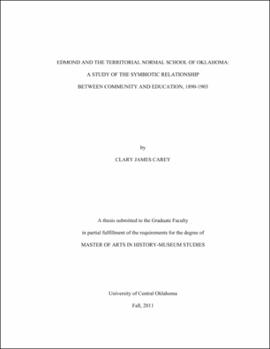| dc.description.abstract | Oklahoma's colorful past is still reflected today in the descendants of those first settlers, the places settled, and the traditions established by its history. The central part of the state has a long and interesting record from the days Native Americans roamed the area to the thousands of Oklahomans living in the region today. The land, the people, and the history of this area built the foundation and framework of one town from its humble beginnings as a watering and coaling station for the Santa Fe Railroad. Little did anyone know the city of Edmond with its unique blend of place and people would become a center for education following the Land Run of 1889. Today, the University of Central Oklahoma educates students from across the United States and the world. In 1891, the Territorial Normal School of Oklahoma (TNSO) started with 25 students. The city and the institution formed a relationship beginning in 1890. The bond created pre-statehood and fostered during the TNSO's formative years has not been studied. This thesis examines the connection between Edmond and the TNSO and allows the reader to understand the symbiotic evolution of the community and school. Several people have written about this university's history, but only touched upon the synergistic relationship between the school and the town during that formative period. Other published works on the history of Edmond have superficially discussed the connection between the two. This work fills the void by exploring various interpretations of the history and events surrounding Edmond's and the Normal School's relationship. Chapters cover the history and geography of the area, the push to open the Unassigned Lands to white settlement, the railroad and Edmond Station, the Land Run of 1889, and the founding of the town in order to ascertain the motives of the town's leadership in lobbying for the establishment of the Normal within Edmond's boundaries. A detailed review of these factors is necessary in order to analyze the growth of both the town and institution especially in light of the various aspects of the interwoven history in the period of 1890 to 1903. Much of the previous scholarship about this subject written in the 1920s, 1950s, 1970s, 1980s, and mid-1990s pays scant attention to the early history. It is time for this subject to be revisited. Understanding the era in which the Oklahoma Territory emerged is important. Such a review can become a tangled mess if scholars only look at the period from the point of view of only one of the entities involved. Analyzing various interpretations and exploring primary sources can create a more robust interpretation of the relationship between Edmond and Central. This thesis delves into the history of Edmond and Central by looking at their earliest connection. Chapter 1 gives a brief history of the geography of the area. It discusses the pre-history of Edmond, including tribal use of the land, the push to open the Unassigned Lands to white settlement, and the railroad and Edmond Station. Chapter 2 opens with the Land Run of 1889, the founding of the town, and the political machinations and forces that led to the establishment of the Territorial Normal School of Oklahoma. Chapter 3 discusses the period of 1890 to 1895 with the growth of the Normal through the help of the city of Edmond, as well as the education provided by the school. Chapter 4 encompasses the years 1895 to 1903, just before the school's first name change, and documents the continuing symbiotic relationship by examining the efforts of the community and the TNSO to help one another. The author of this thesis chose to write on a local history topic, as it is "the most accessible of all history, for it is closest to home." It is the study "of the human condition in and through time ... Doing local history is a process of learning, and it is about explaining causes - the how and the why, of the past." This work supports local history by serving several purposes. One intention is to revisit the narrative about the pre-territorial days of Oklahoma and provide a well-rounded viewpoint of the events leading to the opening of the Unassigned Lands. An examination of the political and historical landscape is vital to the analysis of the evolution of the relationship cultivated between Edmond and Central. Another reason for this study is to relate the story of the Edmond community with its progressive understanding of the importance of education and recognition of the need for a teacher's college, which led to the establishment of the Territorial Normal School of Oklahoma. Finally, the research exposes the interdependent connection between Edmond and the TNSO, an area that has been underserved by historical research and the academic community. This thesis will provide the students, staff, faculty of the University of Central Oklahoma, and Edmond community members a sense of their shared history and an understanding of the distinctive relationship between Edmond and Central. | |
